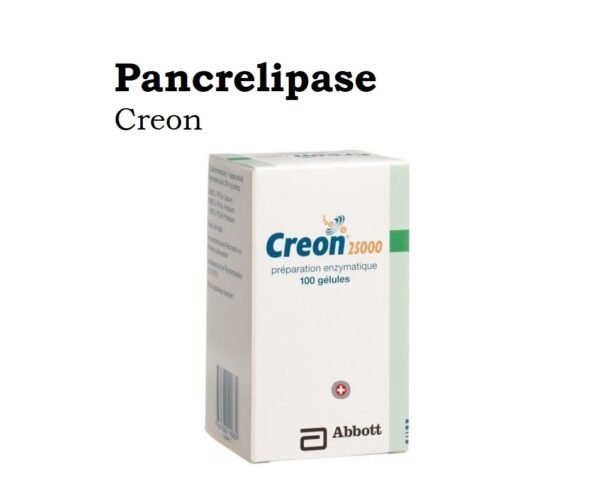Pancrelipase is a preparation of pancreatic enzymes that contain amylases, lipases, and proteases. It is used in patients with malabsorption associated with exocrine pancreatic insufficiency.
Pancrelipase Uses:
-
Pancreatic insufficiency (exocrine):
- Exocrine pancreatic insufficiency treatment caused by cystic fibrosis or other conditions.
- Creon is also approved for chronic pancreatitis patients or pancreatectomy.
- Viokace, in combination with a PPI, is approved for use in exocrine pancreatic insufficiency caused by chronic pancreatitis or pancreatectomy.
- Note: Viokace must be prescribed with a proton pump inhibitor (PPI) since it is not enteric-coated.
Pancrelipase dose in Adults
Note:
- The dose must not exceed the recommended maximum dosage suggested by the Cystic Fibrosis Foundation Consensus Conferences Guidelines.
- Adjust dose according to body weight, clinical symptoms, stool fat content, and the fat content of the diet.
- Allow several days between dose adjustments.
- Total daily dose reflects about ~3 meals per day and 2 to 3 snacks per day, with half the mealtime dose given with a snack.
- Doses of lipase >2,500 units/kg per meal, lipase >10,000 units/kg per day, or lipase >4,000 units/g fat daily should be used with caution and only with documentation of effectiveness by 3-day fecal fat measures indicating a significantly improved coefficient of fat absorption.
- Doses of lipase >6,000 units/kg per meal are associated with colonic stricture and should be reduced.
Pancrelipase dose in the treatment of pancreatic insufficiency due to conditions such as cystic fibrosis:
-
Oral (Creon, Pancreaze, Pertzye, Ultresa, Zenpep):
- Initial: Lipase 500 units/kg per meal.
- Dosage range: Lipase 500 to 2,500 units/kg/meal.
- Maximum: Lipase ≤2,500 units/kg per meal or lipase ≤10,000 units/kg per day or lipase <4,000 units/g of fat daily
Pancrelipase dose in the treatment of pancreatic insufficiency due to chronic pancreatitis or pancreatectomy:
-
Creon:
- Initial: Lipase 500 units/kg/meal with individualized dosage titrations.
- Usually, half the prescribed dose for an individualized full meal should be given with each snack.
- Maximum: Lipase ≤2,500 units/kg per meal or lipase ≤10,000 units/kg per day or lipase <4,000 units/g of fat daily
-
Viokace (administer in combination with a proton pump inhibitor):
- Initial: Lipase 500 units/kg/meal with individualized dosage titration.
- Usually, half the prescribed dose for an individualized full meal should be given with each snack.
- Maximum: Lipase ≤2,500 units/kg/meal or lipase ≤10,000 units/kg per day or lipase <4,000 units/g of fat daily.
Pancrelipase dose in the treatment of exocrine pancreatic insufficiency due to pancreatic cancer (off-label dosing):
- Oral:
- Initial: 25,000 to 50,000 units (lipase) per meal or 1,000 units (lipase)/kg/day or 4,000 units/5 to 7 g fat at each meal;
- escalate the dose based on relief of symptoms;
- maximum dose: 2,500 units (lipase)/kg/meal.
Pancrelipase dose in Childrens
Note:
- Adjust dose based on body weight, clinical symptoms, and stool fat content. Allow several days between dose adjustments.
- Total daily dose reflects ~3 meals/day and 2 to 3 snacks/day, with half the mealtime dose given with a snack. Doses of lipase >2,500 units/kg/meal should be used with caution and only with documentation of 3-day fecal fat measures.
- Doses of lipase >6,000 units/kg/meal are associated with colonic stricture and should be decreased.
Pancrelipase dose in the treatment of pancreatic insufficiency due to cystic fibrosis:
General dosing recommendations:
-
Infants:
- Oral:
- Lipase 2,000 to 5,000 units per feeding of formula, breast milk, or per breastfeeding.
- Maximum daily dose: Lipase 10,000 units/kg/day up to 2,500 units/kg/feeding.
- Oral:
-
Children 1 to <2 years:
Note: Dosage requirements may fluctuate as diet transitions to more solid foods.
- Oral:
- Initial dose: Lipase 1,000 units/kg/meal.
- Dosage range: Lipase 1,000 to 2,500 units/kg/meal.
- Maximum daily dose: Lipase 10,000 units/kg/day or lipase 4,000 units/g of fat/day.
- Higher dosing similar to infant dosing (Lipase: 2,000 to 5,000 units per feeding of formula, breast milk, or per breastfeeding) may be necessary in some patients.
-
Children ≥2 to <4 years:
- Oral:
- Initial dose: Lipase 1,000 units/kg/meal.
- Dosage range: Lipase 1,000 to 2,500 units/kg/meal.
- Maximum daily dose: Lipase 10,000 units/kg/day or lipase 4,000 units/g of fat/day.
- Oral:
-
Children ≥4 years and Adolescents:
- Oral:
- Initial dose: Lipase 500 units/kg/meal.
- Dosage range: Lipase 500 to 2,500 units/kg/meal.
- The maximum daily dose: Lipase 10,000 units/kg/day or lipase 4,000 units per g of fat/day.
- Oral:
Pancrelipase dose in the treatment of Pancreatic enzyme supplementation (enteral tube feedings):
Note: With low-fat or elemental enteral formulas, pancreatic enzyme supplementation may not be necessary.
-
Continuous enteral feeding:
- Oral: Lipase 1,000 units/g of fat provided by the daily amount of feeds administered in divided doses every 2 to 3 hours.
-
Overnight enteral feeding:
- Administer the dose orally before a meal at the beginning of feeding;
- an additional dose may be given midway through or at the end of a feeding.
- Some centers recommend using 1,000 units/g of fat provided by the overnight feed administered in 2 divided doses with the first dose as 50% of requirement or enough to cover 3 hours of feeds and the additional dose given if the patient awakens at night or at the end of a feeding.
Pregnancy Risk Factor C
- Studies on animal reproduction have not been done.
- Pregnancy should be optimized; cystic Fibrosis patients with malabsorption must ensure that nutrition is optimal.
- Pancreatic enzyme replacement in pregnant patients with cystic Fibrosis is not considered to pose a risk to the baby.
Pancrelipase use during breastfeeding:
- It is unknown if pancrelipase can be found in breast milk.
- It is recommended that nursing mothers be cautious when administering pancrelipase.
Pancrelipase Dose in Kidney Disease:
- There are no dosage adjustments provided in the drug manufacturer’s labeling.
- Use with caution.
Pancrelipase Dose in Liver Disease:
- There are no dosage adjustments provided in the drug manufacturer’s labeling.
Common Side Effects of Pancrelipase:
-
Central Nervous System:
- Headache
-
Gastrointestinal:
- Abdominal Pain
-
Hematologic & Oncologic:
- Lymphadenopathy
-
Infection:
- Streptococcal Infection
-
Neuromuscular & Skeletal:
- Neck Pain
-
Otic:
- Otalgia
-
Respiratory:
- Nasal Congestion
Less Common Side Effects Of Pancrelipase:
-
Cardiovascular:
- Peripheral Edema
-
Central Nervous System:
- Dizziness
-
Dermatologic:
- Skin Rash
-
Endocrine & Metabolic:
- Hyperglycemia
- Weight Loss
- Exacerbation Of Diabetes Mellitus
- Hypoglycemia
-
Gastrointestinal:
- Dyspepsia
- Diarrhea
- Flatulence
- Choledocholithiasis
- Pruritus Ani
- Early Satiety
- Vomiting
- Upper Abdominal Pain
- Abnormal Stools
-
Hematologic & Oncologic:
- Anemia
-
Hepatic:
- Ascites
- Hydrocholecystis
-
Infection:
- Viral Infection
-
Renal:
- Renal Cyst
-
Respiratory:
- Cough
- Epistaxis
- Pharyngolaryngeal Pain
- Nasopharyngitis
Contraindications to Pancrelipase:
- The US labeling does not list any contraindications.
-
Canadian labeling:
- Hypersensitivity/Allergy to pancrelipase or any component of the formulation;
- Acute pancreatitis
- Chronic pancreatitis is acutely exacerbated.
Warnings and precautions
-
Fibrosing colonopathy
- Rarely have we seen fibrosing colonopathy progress to colonic strictures.
- High doses and prolonged use may increase the risk for children with cystic Fibrosis. However, the mechanism behind this phenomenon is not known.
- Children aged 12 years have reported colonic stricture when they consume lipase at a rate of more than 6,000 units per meal.
- Patients who are taking lipase doses greater than 6,000 units/kg/meal need to be evaluated and their dose reduced.
- Lipase >2,500 units/kg daily, lipase 10,000 units/kg/day, and lipase 4,000 units/g fat daily should all be avoided.
- Only 3-day fecal fat measurements can document the effectiveness of lipase, which indicates a significantly higher coefficient of fat absorption.
-
Hypersensitivity
- Rarely have severe, allergic reactions, including anaphylaxis and hives, asthma, and pruritus been reported.
- Patients with pork protein allergies should be cautious, taking into account the patient's clinical needs.
-
Mucosal irritation:
- The release of enzymes may occur early by chewing or crushing the tablets or capsules, and mixing them with meals that are not listed on the product labeling.
- This can cause irritation to the buccal mucosa, and/or loss or reduction in enzyme activity.
- To ensure full ingestion, capsules should be swallowed immediately after being mixed with food.
- Mixing pancrelipase with foods that have a pH greater than 4.5 should be avoided
-
Pork
- Porcine pancreatic glands are used to make products.
- Transmission of porcine virus and other diseases caused by unknown or unidentified viruses is a real risk.
- However, it is possible to reduce the risk through testing, inactivation, or removal of certain viruses.
- No cases of infection have been reported.
-
Gout, hyperuricemia:
- Patients with hyperuricemia and gout should be cautious
- Porcine-derived products may contain purines that can raise uric acid levels.
-
Pancreatic cancer:
- The American Society of Clinical Oncology has guidelines that say patients with pancreatic cancer, whether locally advanced or potentially curable, who have exocrine pancreatic dysfunction, may need pancreatic enzyme replacement therapy to increase digestion and absorption.
- An retrospective study of patients with metastatic pancreatic carcinoma suggests that pancreatic enzyme substitution therapy is not being used as much.
-
Renal impairment
- Patients with a deranged renal profile should be cautious
- Porcine-derived products may contain purines that can increase uric acid levels.
Monitoring Parameters:
- Abdominal symptoms,
- nutritional intake,
- weight,
- growth (in children),
- stool character,
- fecal fat
How to administer Pancrelipase?
- Administer with food or snacks and swallow whole content with more amount of fluid.
- Do not crush or chew; retention in the mouth before swallowing may cause oral/mucosal irritation.
- Usually, half of the prescribed dose for an individualized full meal should be administered with each snack.
- The total daily dose should reflect approximately 3 meals a day plus 2 or 3 snacks per day.
Delayed-release Capsules:
- capsules may be opened and components are added to a small amount (approximately 10 mL) of soft acidic food (pH ≤4.5), such as applesauce, If required.
- Do not crush microspheres when mixing.
- The food should be swallowed immediately after mixing with food; do not chew.
- The food temperature should be at room temperature (Creon, Ultresa).
- Follow with water or juice intake to ensure complete ingestion and that no medication stays in the mouth.
Viokace Tablets:
- Tablets are not enteric-coated therefore should be taken with a proton pump inhibitor.
Administration of Pancrelipase via gastrostomy (G) tube:
-
Creon:
- An in vitro study demonstrated that Creon delayed-release capsules sprinkled onto a small amount of baby food (pH <4.5; applesauce or bananas manufactured by both Gerber and Beech-Nut) stirred gently and after 15 minutes was administered through the following G-tubes without significant loss of lipase activity:
- Kimberly-Clark MIC Bolus size 18 French,
- Kimberly-Clark MIC-KEY size 16 French,
- Bard Tri-Funnel size 18 French, and
- Bard Button size 18 French (Shlieout 2011).
- An in vitro study demonstrated that Creon delayed-release capsules sprinkled onto a small amount of baby food (pH <4.5; applesauce or bananas manufactured by both Gerber and Beech-Nut) stirred gently and after 15 minutes was administered through the following G-tubes without significant loss of lipase activity:
-
Pertzye:
- May administer up to two 4,000 unit capsules via G-tube with a diameter of 14 French or a larger diameter tube.
- Thoroughly mix contents of one or two 4,000 unit capsules in ≥10 mL applesauce to create a uniform suspension;
- Do not crush microspheres.
- Administer via a 35 mL slip tip syringe;
- Flush with ~10 mL of water.
- Administer immediately after mixing;
- Do not save for later use.
- Repeat if the dose required is greater than two 4,000 unit capsules.
Mechanism of action of Pancrelipase:
- Pancrelipase is a natural product harvested or produced from the porcine pancreatic glands.
- It contains a combination of lipase, amylase, and proteases enzymes.
- Products are formulated to dissolve in more basic pH of the duodenum so that they can act locally in order to break down fats, protein, and starch.
Absorption:
- None; acts locally in GI tract
Excretion:
- Feces
International Brands of Pancrelipase:
- Creon
- Pancreaze
- Pancrelipase (Lip-Prot-Amyl)
- Pertzye
- Ultresa
- Viokace
- Zenpep
- Cotazym
- Creon
- Pancrease MT
- Ultrase
- Ultrase MT
- Viokase
- A Zyme
- Creon
- Creon 10000
- Creon Forte
- Dipankrin
- Festal-N
- Kreon
- Kreon 10000
- Lipacreon
- Luizym
- Mezym
- Mezym Forte
- Neo-Pancreatinum
- Neo-Panpur
- Norzyme
- Orozim
- Ozym
- Pancrease
- Pancrease HL
- Pancrease MicroTabs
- Pancrefar
- Pancreolan Forte
- Pancrestal
- Pancrex
- Pancrin
- Pancrit
- Pangrol
- Pankreatin
- Pankreoflat
- Pankreon
- Panzynorm
- Panzytrat
- Renzyme
- Suzyme
- Trepetan
- Zymet
Pancrelipase Brand Names in Pakistan:
No Brands Available in Pakistan.



 Injection.webp)
.webp)